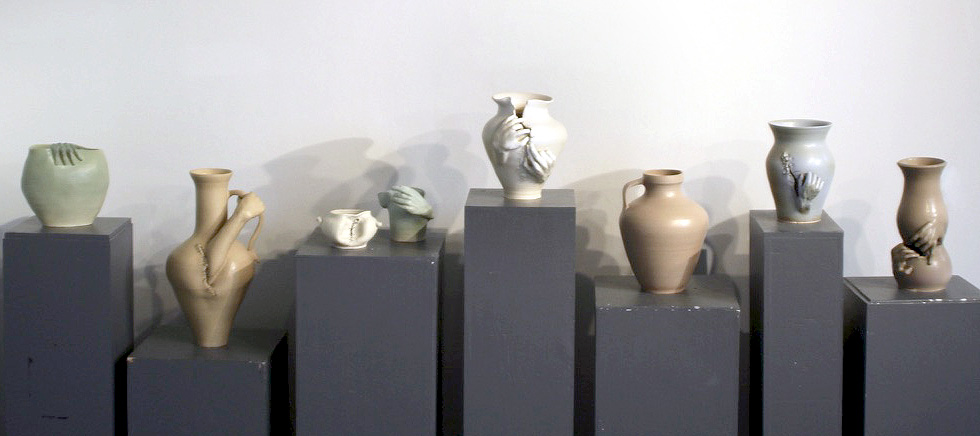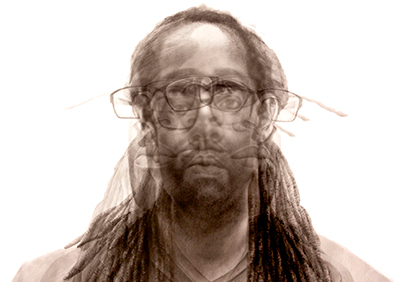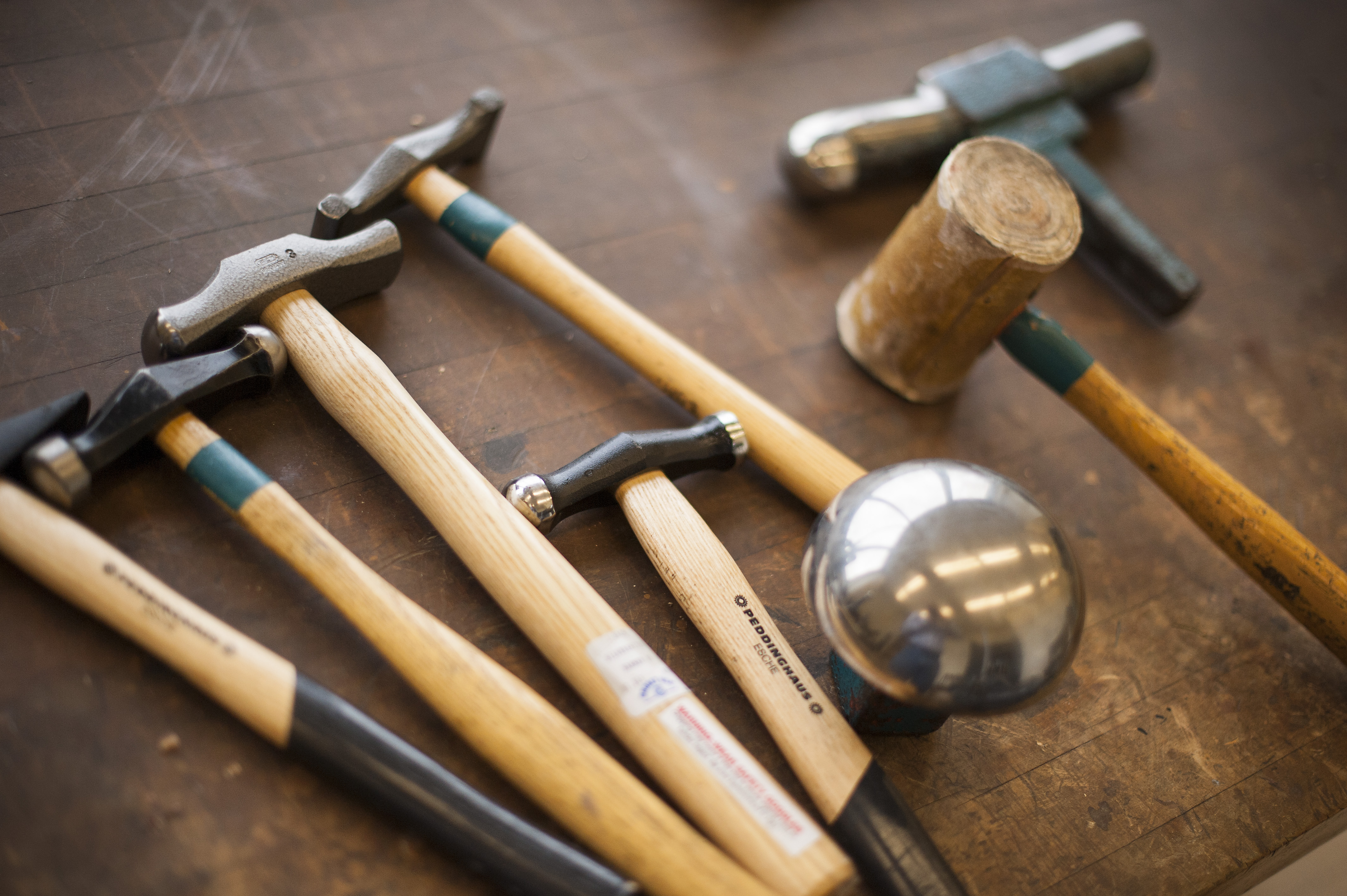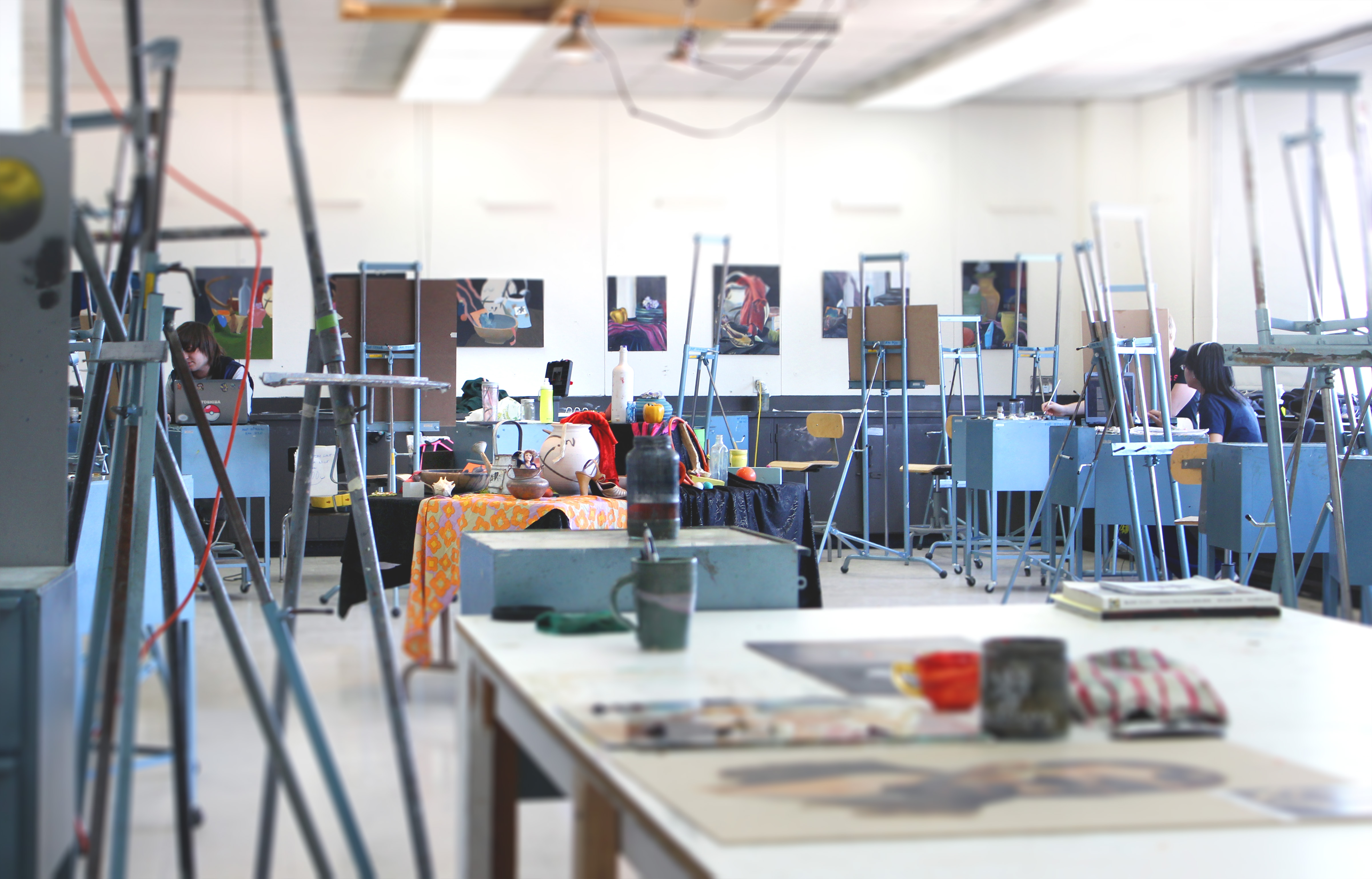
Develop Your Vision, Launch Your Career
If you’re a visual artist looking to deepen your skills and stretch yourself creatively, a BA or BFA in Studio Art at IUP may just be your match. You’ll establish a solid foundation in the fundamentals of studio art, and you’ll have the space to experiment with ideas, explore new materials and formats, and focus on your conceptual abilities. After graduation, studio art majors will be ready to pursue a career in a variety of exciting creative fields.
Explore disciplines within Studio Art:
- Ceramics
- Drawing
- Jewelry and Metals
- Painting
- Sculpture
- Woodworking
What Will You Learn?
As a studio art major, you’ll join a community of artists with a respect for tradition and a commitment to innovation. You’ll be challenged to refine your technical abilities, ensuring you graduate ready to work in the field of your choice or continue your studies.
- Learn a variety of art-making techniques—from traditional modes of artistic production to new digital methods of making.
- Develop proficiency with new materials and formats for artistic expression.
- Practice creative problem solving.
- Learn to promote and present your art in exhibitions and at public events.
- Examine the role of artists in society.
Choose the art studio degree path that’s right for you.
- BA in Studio Art: More flexible and a good fit for transfer students; students hoping to specialize in multiple studio areas; and students pursuing double majors, minors, and/or certificates.
- BFA in Studio Art: Considered the preferred degree for students pursuing careers as artists and designers. Earning your studio art BFA requires additional advanced courses and a declared area of emphasis.
- Minor in Studio Art: Provides students in other departments the opportunity to experience the visual arts in greater depth, including students studying art education or art history.
Imagine Your Future
Over the next decade, overall employment of craft and fine artists is projected to grow at nearly twice the rate of other creative fields. (Source: US Bureau of Labor Statistics)
Career Opportunities for Studio Art Majors
- Architectural fabricator
- Art center director
- Art educator in a museum, community art center, or private art program
- Artist
- Art sales
- Community service worker
- Creative entrepreneur
- Designer
- Display artist
- Furniture maker
- Gallery director or worker
- Illustrator
- Jeweler or metalsmith
- Model maker
- Muralist or public art project artist
- Portraitist
- Restoration or repairs expert
- Set designer
- Technician in museums and galleries
Classes and Requirements
Here’s what to expect as a studio art major.
Start with a Foundation Year
Your journey in studio art begins with gaining a general understanding of two- and three-dimensional art-making through beginning level studios.
Pursue an Area of Focus
You’ll select a specialization and take advanced studio courses that fit your career goals.
Hone Your Professional Practice
In your senior year, you’ll learn critical professional practices, supported by studio art faculty mentors. You’ll work toward a culminating exhibition of your art, giving vision to new ideas and voice to today’s issues.
The Department of Art and Design at IUP is nationally accredited, which means our curriculum, faculty, facilities, and student work meet or exceed the rigorous criteria set forth by the National Association of Schools of Art and Design.
Full Academic Catalog Listing
The course catalog is the official reference for all our degree and course offerings. Check it out for a full listing of the classes available and requirements for this degree.
- Loading...
- Loading...
Art Studio Minor
The minor in studio art provides students in other departments the opportunity to experience the visual arts in greater depth.
Additionally, the minor in studio art is available to students in the Art and Design Department whose major area of study is art education or art history.
Full Academic Catalog Listing
The course catalog is the official reference for all our degree and course offerings. Check it out for a full listing of the classes available and requirements for this degree.
- Loading...

Ceramics
In the ceramics program, you’ll find an emphasis on fostering your personal growth and individual direction as an artist.
- Explore functional, sculptural, and installation approaches to ceramics
- Experiment with materials
- Refine your technical, conceptual, and aesthetic practice
The ceramics studio is a newly renovated, versatile, and safe space in the Robertshaw Building, with separate spaces for hand building and wheel throwing, clay mixing, glazing, plaster mixing, and kilns. Kiln availability includes electric, gas, raku, wood, and soda firing.

Drawing
Drawing is central to any artistic discipline. In the drawing program, you’ll establish a strong base of skills and explore a broad range of ideas and materials to refine your conceptual and technical abilities.
- Learn traditional and contemporary processes
- Begin by solving problems of composition, two- and three-dimensional relationships, and personal expression
- Advance to investigating the language of drawing, aesthetic development, and individual creative vision

Jewelry and Metals
From art to fashion, functional to sculptural, tiny to massive, jewelry and metals is a diverse field. In the jewelry and metals program, you’ll learn the core fundamentals of metalsmithing, and graduate with the critical thinking and conceptual skills necessary to distinguish your work.
- Be challenged to create thoughtful work and original designs using a variety of traditional and experimental methods
- Learn from faculty members with expertise in a variety of metalsmithing techniques and backgrounds in many facets of the field, including gallery sales, arts administration, and international exhibition
- Grow your network by getting involved in regional and national organizations, exhibitions, and events
The jewelry and metals studio is more than 2,000 square feet and includes a large hearth area with hundreds of tools; ventilated rooms for casting and enameling with digital Vcella kilns; and equipment specifically for documenting your work.

Painting
Painting invites us to see possibilities—infinite colors and pigments, historical events and people of times past, and even visions of the future. At IUP, you’ll learn what it takes to be a successful painter within the competitive field of fine arts. Guided by faculty members who are actively exhibiting, professional artists, you’ll be challenged to shape a personal studio practice and prepared for a fulfilling career in art.
- Learn fundamental techniques and basic properties of paint, including traditional painting processes and newer, contemporary methods in well-equipped painting studios
- Hone your ability to think critically and discuss your work in relationship to contemporary art and society
- Develop a personal aesthetic and create a cohesive body of work ready for professional exhibition
Preparing for your future doesn’t end in the studio. You can show your work in Miller Gallery; meet visiting artists and experience their work on campus; become a leader in the Student Art Association; and participate in the vibrant arts community of nearby Pittsburgh.
Sculpture
The sculpture program is on a mission to lead through innovation. As a sculpture student, you’ll shape the physical world in response to the issues of today.
- Experiment with new technology and engage in a rigorous investigation of theory
- Conduct research, starting with a focus on objects
- Advance your studio practice to installation, performance, and social practice
The sculpture studio consists of 7,500 square feet in the Robertshaw Building and includes a fully equipped tool room; woodshop; welding and metal fabrication area; outdoor metal casting facility; dedicated plaster and mold-making area; resin room; and drive-in spray booth. Students also have access to space for the presentation and documentation of their work.
Woodworking
If you’re an emerging artist working in wood, you’ll find your fit in the woodworking program. Develop your skills in artistic design and fine craftsmanship as you learn from professionals actively working in the field. Our program is dedicated to research and development; interdisciplinary projects; community outreach; and the synthesis of traditional and contemporary technologies.
- Master traditional woodworking and furniture design/building processes
- Learn about contemporary technologies and capabilities
- Explore wood as a means of personal expression and develop as a professional woodworker
- Learn directly from working professionals who share their expertise and experience through the Resident Artist/Educator and visiting artist programs
You’ll work in expansive and exceptionally well-equipped studios in Sprowls Hall, comprising nearly 9,000 square feet.
Facilities
Along with museums and galleries, Sprowls Hall is dedicated to seven studio arts, and the 13,000 sq ft Robertshaw building is dedicated to ceramics and sculpture. Learn more about the art facilities at IUP.
Student Opportunities
As an art major, you will have the opportunity to participate in numerous activities that will further enrich your artistic endeavors.
- Show your work: Put together an exhibit of your own work in Miller Gallery, run by the Student Art Association.
- Absorb and be inspired: Enjoy works by faculty and other national and international artists in exhibitions hosted by IUP galleries and museums.
- Join: New friends are waiting in the Student Art Association, Graphic Design Student Association, Clay Club, IUP Fashion Association, Visual Merchandising Club, American Society of Interior Designers (ASID), IUP Chapter, and other art student organizations.
- Learn how art works: Get an internship.
- Make professional connections: Get involved with the campus chapter of the National Art Education Association or check out the American Society of Interior Designers.
- Change perspective: Study abroad on trips for art students. Contact the Artand Design Department Office for information.
- Teach: Students have the opportunity to teach art classes at the Artists Hand Gallery, in Indiana, Pennsylvania.
- Make your mark: The annual Chalk on the Walk art show turns campus grounds into a beautiful spectacle.
Bringing Talent, Enthusiasm, and Diverse Perspectives
The Art and Design Department at IUP consists of 14 full-time professors. They have earned the highest level of academic degrees for their specialty and bring extensive experience and scholarship to the classroom.
Freshman Entrance Portfolio Requirements
Students who have applied to IUP will receive a letter of invitation from the Art and Design Department for a portfolio review.
The goal is to determine whether your portfolio demonstrates potential for success in professional studies in our art program. Your work will be reviewed on the basis of technical, compositional, and creative skill.
Please note, students majoring in Art History or completing a Museum Studies Certificate need not submit a portfolio.
Portfolio Review
Portfolio reviews are an important prerequisite for admission into our degree programs. Students who have applied to IUP will receive a letter of invitation from the Art and Design Department for a portfolio review.
The goal is to determine whether your portfolio demonstrates potential for success in professional studies in our art program. Your work will be reviewed on the basis of technical, compositional, and creative skill.
Prospective students, transfer students, or students who wish to change to an art studio or art education major can submit their portfolio anytime.
The portfolio review process is used to select students for scholarships.
